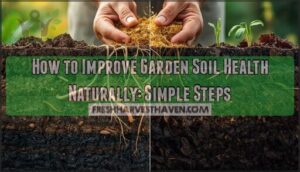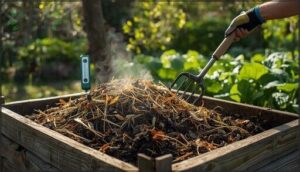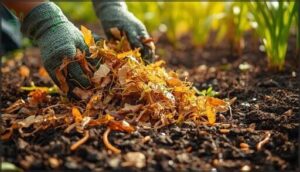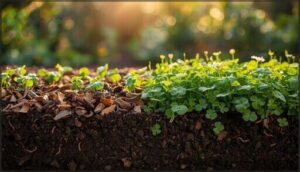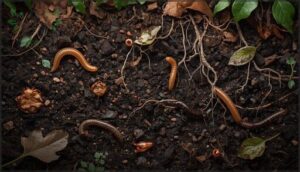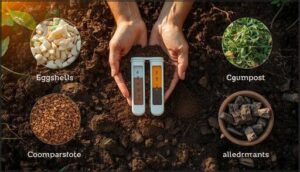This site is supported by our readers. We may earn a commission, at no cost to you, if you purchase through links.
Your garden soil isn’t just dirt—it’s a living ecosystem where billions of microorganisms work around the clock to break down organic matter, cycle nutrients, and support plant roots. When this underground community thrives, your plants grow stronger, resist disease better, and produce more abundantly without relying on synthetic chemicals.
The secret lies in feeding the soil itself rather than just the plants. By adding compost, you can boost soil organic matter by up to 30%, while cover crops reduce erosion by roughly 40% during vulnerable seasons.
Building this foundation takes patience, but the rewards multiply season after season as your soil becomes richer, more resilient, and better able to hold moisture and nutrients where your plants need them most.
Table Of Contents
Key Takeaways
- Building healthy soil starts with feeding the microbes rather than just the plants—adding compost can boost organic matter by 30%, while cover crops cut erosion by 40% and create a living foundation that gets stronger each season.
- Your best soil amendments work together like a toolkit: compost and aged manure provide slow-release nutrients, mulch retains up to 50% more moisture while preventing erosion, and materials like biochar and mycorrhizal fungi create lasting improvements in structure and nutrient availability.
- Protecting soil life means leaving it undisturbed—no-till practices reduce erosion by over 80%, while earthworms and deep-rooted cover crops naturally aerate compacted ground and boost microbial populations without heavy equipment.
- Smart nutrient management comes from rotating crops to balance what plants take and give back, testing soil every 2-3 years to avoid overfeeding, and watering carefully to prevent nutrients from washing away before roots can use them.
Build Healthy Soil With Organic Matter
Think of organic matter as the foundation of thriving garden soil—it feeds beneficial microbes, improves structure, and helps retain moisture and nutrients. You don’t need fancy products or complicated techniques to get started.
Let’s look at four simple ways to build healthier soil using materials you probably already have or can easily find.
Adding Homemade Compost
Adding compost to your garden beds can boost soil organic matter by up to 30%, transforming tired earth into a nutrient powerhouse. You’ll increase water-holding capacity, encourage beneficial microbes, and supply slow-release nitrogen that feeds plants without burning roots.
Homemade compost enriches soil structure naturally, helping you grow healthier crops while recycling kitchen scraps and yard waste right in your backyard.
Compost can greatly boost soil’s water retention, especially in sandy soils.
Using Aged Manure Safely
Manure composting transforms raw waste into safe soil amendments when you maintain temperatures between 131°F and 140°F for several weeks. This manure management approach ensures nutrient balance while protecting your family from harmful bacteria. Proper manure aging process is vital for eliminating pathogens and weed seeds.
To use aged manure safely, you’ll want to:
- Mix 1 part manure with 2 parts brown material for pathogen reduction
- Turn your pile every 1–2 weeks to sustain heat
- Apply at least 90–120 days before harvest
Incorporating Shredded Leaves and Grass Clippings
You probably already have two free soil boosters sitting in your yard right now. When you shred leaves and mix them with grass clippings, you create organic matter that improves soil structure while feeding beneficial microbes. Here’s what each brings to your garden:
| Material | Primary Benefit | Timeline |
|---|---|---|
| Shredded leaves | Soil aeration and moisture retention | 6 months decomposition |
| Grass clippings | Nitrogen release (4% content) | 2-4 weeks breakdown |
| Combined mulch | Weed suppression and temperature regulation | Ongoing benefits |
A two-inch layer of this mulch blocks weed seeds from germinating while keeping soil moisture steady. Your grass clippings act like slow-release fertilizer, delivering nitrogen, potassium, and phosphorus exactly when plants need them. Meanwhile, leaf decomposition creates spaces in compacted soil, letting roots breathe and water penetrate deeper.
The real magic happens below ground. As these materials break down, earthworms move in, microbial activity increases, and your soil transforms into something living. In clay gardens, you’ll notice softer, easier-to-work soil within four to five years. Sandy soils become sponge-like, holding onto moisture during dry spells.
As organic matter breaks down, earthworms and microbes transform lifeless dirt into living soil that holds moisture and works easier
Mix three parts dried leaves with one part fresh grass clippings for best results. This ratio prevents nitrogen depletion while speeding up decomposition. You can also steep this combination in water to brew compost tea, a liquid fertilizer that delivers nutrients directly to plant roots.
Studies show soil water content increases by roughly 4% with organic mulches, which means less watering and healthier plants. Even better, you’re recycling yard waste instead of bagging it. Mow over autumn leaves to shred them easily, then spread them around perennials, vegetables, or fruit trees. Your soil—and your back—will thank you.
Benefits of Leaf Mold and Worm Castings
Two other soil heroes deserve attention: leaf mold and worm castings. Leaf mold works like a sponge, holding five times its weight in water while supporting fungal growth that plants love. Worm castings deliver 4-5% nitrogen plus beneficial microbes that suppress disease.
Together, they provide organic matter for soil conditioning, a microbial boost, and steady nutrient release without burning tender roots.
Protect and Enrich Soil With Mulch and Cover Crops
Your soil needs a protective shield, and nature offers two powerful tools: mulch and cover crops. Both work to guard against erosion, lock in moisture, and feed the living community beneath the surface.
Let’s explore how to choose and use these soil guardians effectively in your garden.
Choosing The Right Mulch Materials
Your garden is like a living quilt, and mulch is the blanket it needs. When you choose mulch materials, you’re making a decision that affects soil health, moisture retention, and plant growth. Consider these three key factors:
- Organic vs. inorganic options – Shredded leaves, grass clippings, and pine needles decompose to enrich soil, while gravel lasts longer but adds nothing
- Climate considerations – Pine bark drains well in wet regions
- Soil type and plant needs – Match materials to your garden’s specific requirements and aesthetic preferences
Sowing Cover Crops for Soil Protection
When you’re looking to shield your soil from erosion and build its vitality, planting cover crops like crimson clover or winter rye offers considerable protection.
Growing cover crops reduces soil erosion by about 40% during vulnerable seasons, while their biomass incorporation feeds soil microbes and aids nutrient cycling.
These living shields improve water infiltration and soil aggregation, transforming bare ground into a thriving foundation for future harvests.
Green Manure for Nutrient Enrichment
Green manure transforms your cover crops into powerful soil boosters by turning living plants directly into the earth before they set seed. When you incorporate legumes like clover or alfalfa, you’re basically delivering a nitrogen feast to your soil microbes.
Here’s what this practice brings to your garden:
- Nitrogen fixation by legumes can add 150–500 pounds of nitrogen per acre annually
- Nutrient cycling improves with 22% more alkaline nitrogen and 31% more phosphorus
- Carbon sequestration increases soil organic carbon by roughly 12%
- Crop yield stays strong even with reduced synthetic fertilizer use
This approach nourishes soil health while supporting the microbial communities that make nutrients plant-available.
Mulching to Retain Moisture and Prevent Erosion
Think of mulch as a protective blanket that does double duty for your soil. When you spread a 2–4 inch layer of wood chips or straw, you’ll slash water loss by up to 50% while cutting erosion by roughly half.
Mulch water retention keeps roots hydrated longer, and the material types you choose—whether organic matter like leaves or bark—regulate soil temperature, suppress weeds, and boost biological health as they decompose.
Boost Soil Fertility With Natural Amendments
Once your soil has a solid foundation of organic matter and protective mulch, you can fine-tune its fertility with targeted natural amendments.
These materials work like specialized tools in your gardening toolkit, each bringing specific nutrients or benefits that address different soil needs.
Let’s look at four powerful amendments that can take your soil from good to thriving.
Applying Bone Meal and Fish Emulsion
When you want to feed your garden soil without synthetic chemicals, bone meal and fish emulsion are two natural fertilizers worth understanding. Application rates matter: work 1 to 4 pounds of bone meal per 100 square feet into your topsoil before planting, or mix 1 to 2 tablespoons of fish emulsion per gallon of water for a maintenance feeding every few weeks.
Here’s how they help:
- Bone meal delivers phosphorus and calcium slowly, supporting root development and improving soil health over multiple seasons with minimal environmental impact
- Fish emulsion provides readily available nitrogen for leafy growth while stimulating beneficial soil microbes
- Amendment blending and soil testing help you match nutrient timing to your plants’ needs
Using Seaweed and Kelp for Trace Minerals
Seaweed and kelp bring over 60 trace minerals your soil can’t get from typical fertilizers, including iron, zinc, and manganese that plants need but often lack.
These natural soil amendments improve mineral bioavailability through organic chelation, making nutrients easier for roots to absorb.
As sustainable harvesting grows, more gardeners turn to these fertilizer alternatives to strengthen soil structure, boost plant stress resistance, and improve overall soil health without synthetic inputs.
Benefits of Biochar for Soil Health
Biochar application delivers impressive returns for your soil’s long-term health. This charcoal-like material boosts nutrient retention—holding nitrogen and phosphorus right where roots need them—while reducing fertilizer runoff by 50-80%. Its porous structure also shelters beneficial microbes, encouraging microbial growth that cycles nutrients efficiently.
You’ll notice three major benefits:
- Increased soil carbon sequestration lasting thousands of years
- Improved water dynamics and moisture retention in sandy soils
- Enhanced soil structure through better aggregation and reduced compaction
Introducing Mycorrhizal Fungi
Mycorrhizae create an underground fungal network that forms a soil symbiosis with 80-90% of garden plants, multiplying your root’s absorbing area up to tenfold. These beneficial microbes bring mycorrhizal benefits through improved nutrient uptake—especially phosphorus—while their fungi diversity fosters microbial interactions throughout the soil ecosystem.
When you add mycorrhizal inoculants to organic matter-rich beds, you’re strengthening soil health and building resilience naturally.
Encourage Soil Life and Structure
Healthy soil isn’t just dirt—it’s a living system teeming with organisms that work together to break down organic matter, cycle nutrients, and build structure. When you support this underground ecosystem, you’ll see stronger plants, better water retention, and soil that practically takes care of itself.
Let’s look at four practical ways to encourage the life and structure your soil needs to thrive.
Promoting Earthworms and Beneficial Insects
You can think of earthworms as your garden’s underground workforce—they aerate soil, boost drainage, and release nutrients. Adding organic matter like compost or cover crops doubles or triples earthworm populations within a year.
Meanwhile, beneficial insects provide ecosystem services like pollination and pest control. Organic practices support soil biodiversity, creating diverse insect communities that strengthen your soil ecosystem through natural fertilizers and enhanced nutrient cycling.
Reducing Soil Disturbance and Practicing No-till
Keeping earthworms happy means leaving their home intact. No-till farming protects soil structure by eliminating plowing, which preserves beneficial microbes and reduces soil erosion by over 80% compared to conventional methods. Residue management—leaving crop debris on the surface—shields soil from rain impact and improves water retention.
- No-till benefits include reduced compaction and preserved water-conducting pores
- Erosion prevention improves dramatically, with some studies showing 90% reductions
- Improving soil health happens faster when you stop disturbing underground networks
- Notill gardening increases organic matter levels, especially in surface layers
Aerating Compacted Soil Naturally
When soil compaction chokes your garden, you can reverse the damage without heavy machinery. Manual aeration using garden forks creates holes 4–6 inches deep and restores oxygen flow—infiltration rates can jump from 0.25 inch/hour to over 1 inch/hour. But biological aerators work even better over time.
| Method | How It Works | Impact on Soil Structure |
|---|---|---|
| Manual Aeration | Garden forks create holes 4–6 inches deep | Quadruples water infiltration rates |
| Biological Aerators | Earthworms tunnel, roots rupture compacted layers | 80%+ increase in microbial populations |
| Deep-rooted Cover Crops | Daikon radish, clover penetrate deep | 30% improvement in water infiltration |
Earthworm activity correlates strongly with porosity increases—their tunnels become permanent air channels. Deep-rooted plants like daikon radish physically break through hardpan layers, improving subsoil aeration and reducing surface runoff by more than 35%. Amending compacted soil with 33% organic matter by volume in sandy loam (or 50% in clay loam) reduces bulk density below root-restrictive thresholds. That’s why combining organic amendments with cover crops prevents compaction from returning, giving you lasting improvements to soil aeration and overall structure.
Supporting Soil Microbes With Organic Practices
Your garden thrives when you feed the billions of microbes working beneath your feet. Organic soil boosters like compost and mulch increase microbial activity by 64–76% compared to chemical fertilizers, while natural fertilizer options preserve soil microbial balance.
These microbe-friendly methods boost beneficial bacteria and fungi that cycle nutrients, transforming organic matter into plant-available compounds. Ecofriendly gardening tips centered on soil amendments create lasting fertility.
Manage Soil PH and Nutrients Naturally
Managing your soil’s pH and nutrient levels naturally keeps your plants thriving without relying on synthetic chemicals. You don’t need a chemistry degree to get this right—just a few thoughtful practices that work with nature’s rhythms.
Let’s look at three simple approaches that help you maintain balanced, fertile soil season after season.
Rotating Crops to Balance Nutrients
When you think of crop rotation as nature’s way of rebalancing the soil’s nutrient bank, it makes sense why rotating crops for healthy soil is so effective. Here’s what this practice does for fertility management:
- Legume integration fixes atmospheric nitrogen, cutting synthetic fertilizer needs by 41–46%
- Diversified rotations boost yields by 20% on average while improving soil nutrient cycling
- Cover crops reduce pest pressure by 24–34%, supporting microbial balance
- Crop rotation benefits extend to healthier soil structure and more stable harvests
You’re basically letting different plants take turns, so nutrients and soil health stay in harmony.
Avoiding Overuse of Manure and Fertilizers
More isn’t always better with nutrients. Overusing organic fertilizer or manure can cause root burn, salt buildup, and nutrient runoff that pollutes waterways.
Soil testing before you apply anything helps you avoid excess—phosphorus over 100 ppm means skip the manure. Manure analysis near application time keeps you on track, protecting both your plants and the environment from chemical fertilizers’ harmful effects.
Watering Wisely to Prevent Nutrient Leaching
Too much water doesn’t just drown roots—it washes away nutrients before plants can use them. Watering techniques matter for root health and moisture retention. Here’s how sensor technology and irrigation timing help you water wisely:
- Schedule watering between dew periods to protect nutrients in different soil types
- Use moisture sensors to match water availability with actual plant needs
- Apply only what the root zone holds to preserve water quality
- Avoid soggy conditions that trigger leaching in any soil
Frequently Asked Questions (FAQs)
How often should I test my soil?
University extensions recommend checking every two to three years for most gardens, though vegetable beds and sandy soils benefit from annual testing.
Regular monitoring catches deficiencies before plants show symptoms, saving time and money.
Can I use fresh manure in gardens?
You shouldn’t apply fresh manure directly to vegetable gardens due to pathogen risks like E. coli and Salmonella.
Composting benefits soil health while meeting manure regulations, making aged organic matter safer for improving soil fertility.
What causes soil to become compacted over time?
Soil compaction occurs due to several factors, including heavy machinery crushing pore spaces, tillage practices breaking down structure, and rainfall impact saturating and collapsing aggregates.
Additionally, livestock pressure trampling surface layers and organic matter loss weakening soil’s natural resilience contribute to this issue.
How do I fix extremely acidic soil?
Testing your soil pH comes first, then apply agricultural lime to raise acidity levels naturally. You can also incorporate compost or biochar—both boost pH while enriching your soil with beneficial microbes and organic matter.
Which cover crops work best in shade?
Crimson clover, white clover, and rye top the list for shade-tolerant crops, thriving with under four hours of sun.
Rye-legume mixtures excel in biomass production, supporting soil shade management, while field peas and oats struggle.
Conclusion
Think of your garden soil like a savings account—every deposit of compost, every cover crop, every mindful practice compounds over time into something far more valuable than what you started with.
When you improve garden soil health naturally, you’re not just feeding this season’s tomatoes; you’re building a foundation that gets stronger with each passing year.
The microbes, the earthworms, the structure—they’re all working for you, transforming simple ingredients into abundant harvests that prove nature’s wisdom always outperforms shortcuts.
- https://extension.psu.edu/practical-tips-for-healthy-soil-in-a-home-garden/
- https://www.frontiersin.org/journals/soil-science/articles/10.3389/fsoil.2022.1096735/full
- https://oiccpress.com/ijrowa/article/view/8144
- https://www.lsuagcenter.com/articles/page1694723868853
- https://farmonaut.com/blogs/crop-rotation-chart-soil-health-fertility-benefits-data

